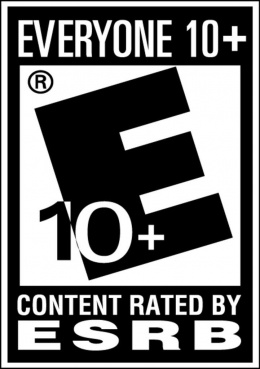
An example of a rating from the ESRB found on video game boxes in North America. This rating Everyone 10+ generally denotes a game suitable for an audience above the age of 10.
Video game content rating systems are designed to be standardized systems serving the purpose of classifying video games based on their suitability for target audiences. The body responsible for the regulation varies from country to country and follows standards set by that specific region. Some of these regulatory systems are independent, while others are run or guided by their government. Given the vast amount of national rating boards, some developers have called for an international regulatory body to be formed to standardize these ratings on a global scale. [1] In response, the International Age Rating Coalition (IARC), was introduced seeking to become the sole rating board globally, while still reflecting the unique cultural differences among nations and regions. [2] However, it is important to note that only countries and regions that are not represented by a participating rating authority recognize the legitimacy of this system.[3]
History
In 1993 Sen. Joseph Lieberman sponsored legislation that would force the video game industry to create a rating system to inform parents of game content.[4] Lieberman would take a strong stance saying in a news conference, “We’re talking about video games that glorify violence and teach children to enjoy inflicting the most gruesome forms of cruelty imaginable.”[5] He pushed further, going as far as to argue that these games lead to real crimes. [6] Consequently, representatives of the video game industry were called to a congressional hearing of the issue in December of 1993.[7] However, prior to the hearing, Sega decided to create its own rating system called the Videogame Rating Council. Officially launching in May 1993, it was the first rating system used by a major publisher in the United States and was heavily influenced by the motion picture industry rating system.[8] The eventual hearing would result in the formation of the Video Game Ratings Act of 1994, which would have been a federal game rating commission. However, the video game industry instead chose to create its own rating system, thus killing the need for the bill. The Interactive Digital Software Association, later known as the Entertainment Software Association, was formed to tackle the matter. Later in 1994, a coalition of game publishers, under the Interactive Digital Software Association, proposed to the United States Congress their idea for the national game rating board to be created. It was accepted and the ESRB was made official on Sept. 1, 1994. The rating system launched with 5 ratings: EC(Early Childhood), K-A(Kids to Adults), T(Teen), M(Mature), and AO(Adults Only).[7] Other countries followed suit, with the Pan-European Game Information rating system being created in Europe in 2003 [9] and the Computer Entertainment Rating Organization in Japan in 2002.[10]
Criticism and Ethical Concerns
Popular Rating Systems
Computer Entertainment Rating Organization
| Rating |
Description
|
|
Games with a rating of Cero A are meant for all ages. Any content that could lead to an age restriction is avoided in these games.
|
|
Games with a rating of Cero B are meant for ages 12+. Only content suitable for the 12+ demographic is included in these games.
|
|
Games with a rating of Cero C are meant for ages 15+. Only content suitable for the 15+ demographic is included in these games.
|
|
|
Games with a rating of Cero D are meant for ages 17+. This typically indicates adult content is present.
|
|
Games with a rating of Cero Z are meant for ages 18+. Adult-only content is present and this game can not be sold or distributed to anyone under the age of 18.
|
Entertainment Software Rating Board
| Rating |
Description
|
|
|
Example
|
|
|
Example
|
|
|
Example
|
|
|
Example
|
|
|
Example
|
International Age Rating Coalition
Rating
| ! Description
|
| Example |
Example
|
| Example |
Example
|
| Example |
Example
|
| Example |
Example
|
| Example |
Example
|
Pan European Game Information
| Rating |
Description
|
| Example |
Example
|
| Example |
Example
|
| Example |
Example
|
| Example |
Example
|
| Example |
Example
|
References










